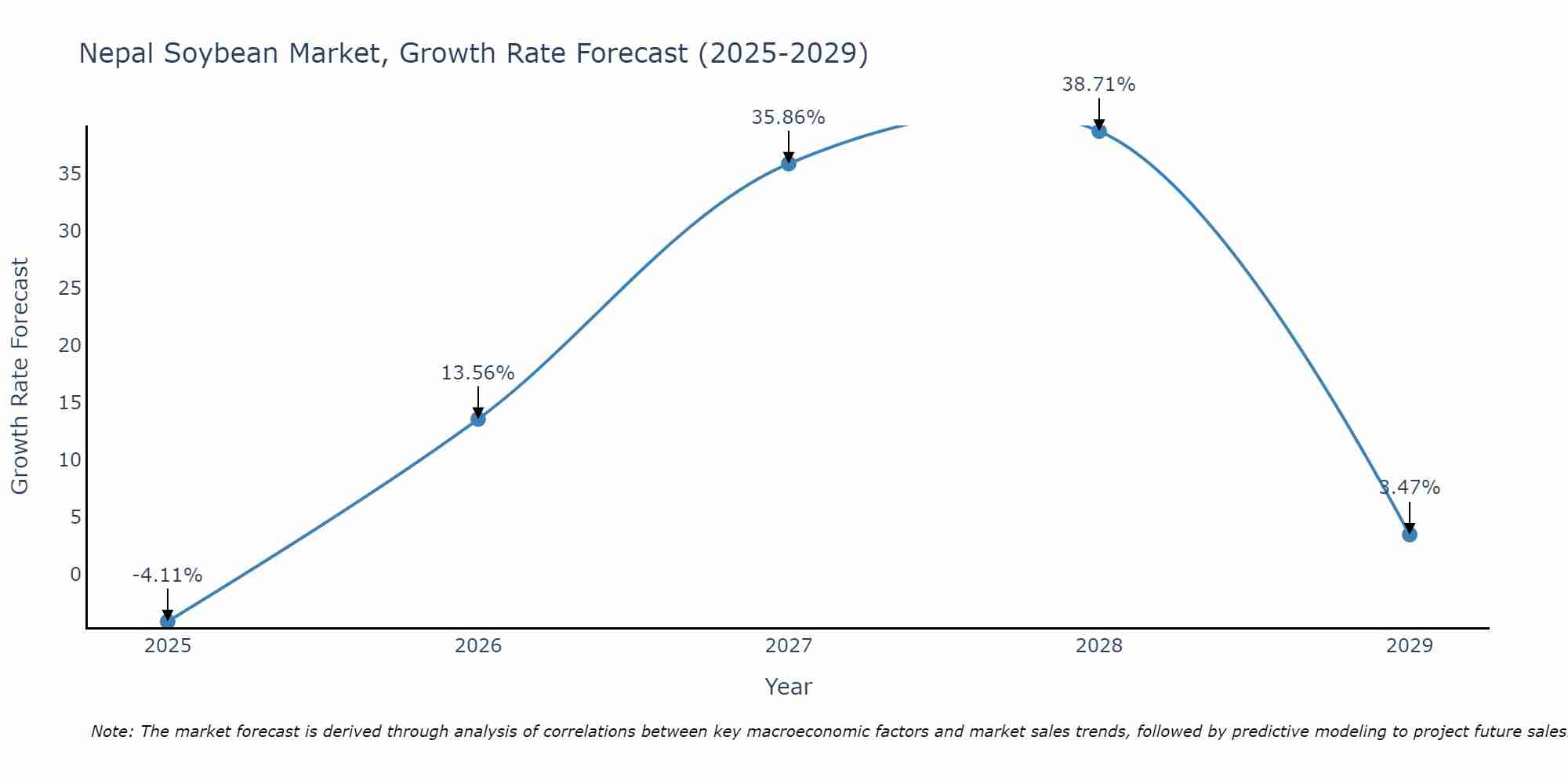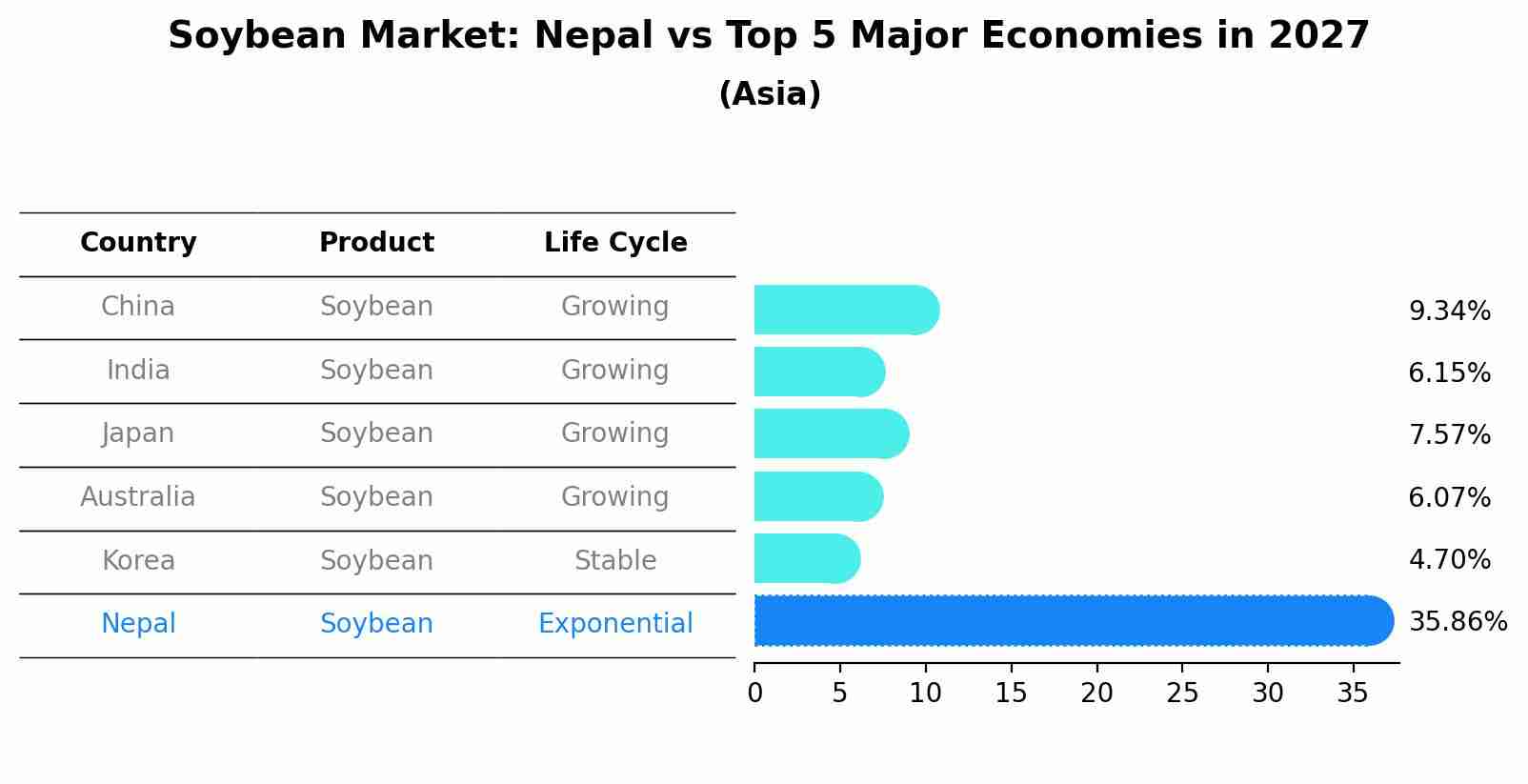Nepal Soybean Market (2025-2031) Outlook | Forecast, Value, Share, Analysis, Industry, Growth, Revenue, Trends, Companies & Size
| Product Code: ETC224676 | Publication Date: Aug 2022 | Updated Date: Aug 2025 | Product Type: Market Research Report | |
| Publisher: 6Wresearch | Author: Summon Dutta | No. of Pages: 75 | No. of Figures: 35 | No. of Tables: 20 |
Nepal Soybean Market Size Growth Rate
The Nepal Soybean Market is projected to witness mixed growth rate patterns during 2025 to 2029. The growth rate begins at -4.11% in 2025, climbs to a high of 38.71% in 2028, and moderates to 3.47% by 2029.

Soybean Market: Nepal vs Top 5 Major Economies in 2027 (Asia)
The Soybean market in Nepal is projected to grow at a exponential growth rate of 35.86% by 2027, within the Asia region led by China, along with other countries like India, Japan, Australia and South Korea, collectively shaping a dynamic and evolving market environment driven by innovation and increasing adoption of emerging technologies.

Nepal Soybean Market Overview
The Nepal soybean market has been steadily growing due to increasing awareness of the health benefits associated with soy products. The demand for soybeans in Nepal is primarily driven by the expanding food and beverage industry, as well as the rising popularity of soy-based meat alternatives. Local farmers are also increasingly cultivating soybeans as a cash crop, further boosting production levels. However, challenges such as limited arable land and fluctuations in weather patterns pose a threat to the market`s growth. To capitalize on the increasing demand, key players in the Nepal soybean market are focusing on product innovation, sustainable farming practices, and strengthening distribution networks. Overall, the Nepal soybean market shows promise for further expansion in the coming years.
Nepal Soybean Market Trends
The Nepal soybean market is experiencing a growing demand for soy products due to the increasing awareness about the health benefits associated with soy consumption. The market is witnessing a shift towards plant-based protein sources, driving the demand for soybeans and soy-based products. Additionally, the government`s focus on promoting sustainable agriculture practices is encouraging farmers to cultivate soybeans, leading to a rise in domestic production. Imports of soybeans are also on the rise to meet the growing demand from various industries such as food processing, animal feed, and cosmetics. Overall, the Nepal soybean market is poised for growth with a focus on sustainable production practices and increasing consumer preference for healthy and plant-based food options.
Nepal Soybean Market Challenges
In the Nepal soybean market, one of the main challenges faced is the heavy reliance on imports due to insufficient domestic production. This dependency on imported soybeans makes the market vulnerable to fluctuations in international prices and exchange rates, impacting the overall profitability of players in the industry. Additionally, limited awareness and adoption of modern farming practices among local farmers hinder the potential for increased soybean cultivation in Nepal. Infrastructure constraints, including inadequate storage and transportation facilities, also pose challenges in maintaining the quality and supply chain efficiency of soybeans. Addressing these challenges through investments in agricultural technology, farmer education programs, and infrastructure improvements will be crucial for the sustainable growth of the soybean market in Nepal.
Nepal Soybean Market Investment Opportunities
Investment opportunities in the Nepal soybean market are promising due to the increasing demand for soybean products in the country. Investors can consider opportunities in soybean cultivation, processing, and distribution. Investing in soybean farming can yield good returns as Nepal has suitable agro-climatic conditions for soybean cultivation. Additionally, setting up soybean processing facilities to produce soybean oil, soy flour, and other soy-based products can cater to the growing consumer demand for healthier food options. Furthermore, investing in distribution channels to efficiently reach consumers can also be a lucrative opportunity. With the government`s focus on promoting agriculture and the rising awareness of the health benefits of soy products, the Nepal soybean market presents attractive investment prospects for both local and foreign investors.
Nepal Soybean Market Government Policy
The government of Nepal has implemented several policies to support the soybean market in the country. These policies include providing subsidies for soybean production, promoting research and development in soybean cultivation techniques, and offering support for farmers to increase productivity and quality. Additionally, the government has focused on increasing domestic production to reduce reliance on imports, as well as improving market infrastructure and access to credit for soybean farmers. By creating a conducive environment for soybean cultivation and ensuring market stability, the government aims to enhance food security, boost rural livelihoods, and contribute to the overall agricultural sector`s growth in Nepal.
Nepal Soybean Market Future Outlook
The future outlook for the Nepal Soybean Market appears positive due to increasing consumer awareness of the health benefits associated with soy products. As consumers become more health-conscious, there is a growing demand for plant-based protein sources like soybeans. Additionally, the government`s initiatives to promote soybean cultivation and improve agricultural practices are expected to boost domestic production. The market also has the potential for export growth as Nepal aims to increase its agricultural exports. However, challenges such as fluctuating global soybean prices and competition from other protein sources may impact market dynamics. Overall, with the right strategies and investments in place, the Nepal Soybean Market is poised for growth in the coming years.
Key Highlights of the Report:
- Nepal Soybean Market Outlook
- Market Size of Nepal Soybean Market, 2024
- Forecast of Nepal Soybean Market, 2031
- Historical Data and Forecast of Nepal Soybean Revenues & Volume for the Period 2021 - 2031
- Nepal Soybean Market Trend Evolution
- Nepal Soybean Market Drivers and Challenges
- Nepal Soybean Price Trends
- Nepal Soybean Porter's Five Forces
- Nepal Soybean Industry Life Cycle
- Historical Data and Forecast of Nepal Soybean Market Revenues & Volume By Applications for the Period 2021 - 2031
- Historical Data and Forecast of Nepal Soybean Market Revenues & Volume By Crush for the Period 2021 - 2031
- Historical Data and Forecast of Nepal Soybean Market Revenues & Volume By Feed Use for the Period 2021 - 2031
- Historical Data and Forecast of Nepal Soybean Market Revenues & Volume By Food Use for the Period 2021 - 2031
- Nepal Soybean Import Export Trade Statistics
- Market Opportunity Assessment By Applications
- Nepal Soybean Top Companies Market Share
- Nepal Soybean Competitive Benchmarking By Technical and Operational Parameters
- Nepal Soybean Company Profiles
- Nepal Soybean Key Strategic Recommendations
Frequently Asked Questions About the Market Study (FAQs):
1 Executive Summary |
2 Introduction |
2.1 Key Highlights of the Report |
2.2 Report Description |
2.3 Market Scope & Segmentation |
2.4 Research Methodology |
2.5 Assumptions |
3 Nepal Soybean Market Overview |
3.1 Nepal Country Macro Economic Indicators |
3.2 Nepal Soybean Market Revenues & Volume, 2021 & 2031F |
3.3 Nepal Soybean Market - Industry Life Cycle |
3.4 Nepal Soybean Market - Porter's Five Forces |
3.5 Nepal Soybean Market Revenues & Volume Share, By Applications, 2021 & 2031F |
4 Nepal Soybean Market Dynamics |
4.1 Impact Analysis |
4.2 Market Drivers |
4.2.1 Increasing awareness about the health benefits of soybean products |
4.2.2 Growing demand for plant-based protein sources |
4.2.3 Government initiatives to promote soybean cultivation and processing |
4.3 Market Restraints |
4.3.1 Limited technological advancements in soybean cultivation and processing in Nepal |
4.3.2 Dependence on imported soybean products due to insufficient local production |
5 Nepal Soybean Market Trends |
6 Nepal Soybean Market, By Types |
6.1 Nepal Soybean Market, By Applications |
6.1.1 Overview and Analysis |
6.1.2 Nepal Soybean Market Revenues & Volume, By Applications, 2021 - 2031F |
6.1.3 Nepal Soybean Market Revenues & Volume, By Crush, 2021 - 2031F |
6.1.4 Nepal Soybean Market Revenues & Volume, By Feed Use, 2021 - 2031F |
6.1.5 Nepal Soybean Market Revenues & Volume, By Food Use, 2021 - 2031F |
7 Nepal Soybean Market Import-Export Trade Statistics |
7.1 Nepal Soybean Market Export to Major Countries |
7.2 Nepal Soybean Market Imports from Major Countries |
8 Nepal Soybean Market Key Performance Indicators |
8.1 Percentage increase in soybean cultivation area in Nepal |
8.2 Adoption rate of modern soybean cultivation techniques |
8.3 Average yield per hectare of soybean crops in Nepal |
9 Nepal Soybean Market - Opportunity Assessment |
9.1 Nepal Soybean Market Opportunity Assessment, By Applications, 2021 & 2031F |
10 Nepal Soybean Market - Competitive Landscape |
10.1 Nepal Soybean Market Revenue Share, By Companies, 2024 |
10.2 Nepal Soybean Market Competitive Benchmarking, By Operating and Technical Parameters |
11 Company Profiles |
12 Recommendations |
13 Disclaimer |
- Single User License$ 1,995
- Department License$ 2,400
- Site License$ 3,120
- Global License$ 3,795
Search
Thought Leadership and Analyst Meet
Our Clients
Related Reports
- Afghanistan Apparel Market (2026-2032) | Growth, Outlook, Industry, Segmentation, Forecast, Size, Companies, Trends, Value, Share, Analysis & Revenue
- Canada Oil and Gas Market (2026-2032) | Share, Segmentation, Value, Industry, Trends, Forecast, Analysis, Size & Revenue, Growth, Competitive Landscape, Outlook, Companies
- Germany Breakfast Food Market (2026-2032) | Industry, Share, Growth, Size, Companies, Value, Analysis, Revenue, Trends, Forecast & Outlook
- Australia Briquette Market (2025-2031) | Growth, Size, Revenue, Forecast, Analysis, Trends, Value, Share, Industry & Companies
- Vietnam System Integrator Market (2025-2031) | Size, Companies, Analysis, Industry, Value, Forecast, Growth, Trends, Revenue & Share
- ASEAN and Thailand Brain Health Supplements Market (2025-2031) | Strategy, Consumer Insights, Analysis, Investment Trends, Opportunities, Growth, Size, Share, Industry, Revenue, Segments, Value, Segmentation, Supply, Forecast, Restraints, Outlook, Competition, Drivers, Trends, Demand, Pricing Analysis, Competitive, Strategic Insights, Companies, Challenges
- ASEAN Bearings Market (2025-2031) | Strategy, Consumer Insights, Analysis, Investment Trends, Opportunities, Growth, Size, Share, Industry, Revenue, Segments, Value, Segmentation, Supply, Forecast, Restraints, Outlook, Competition, Drivers, Trends, Demand, Pricing Analysis, Competitive, Strategic Insights, Companies, Challenges
- Europe Flooring Market (2025-2031) | Outlook, Share, Industry, Trends, Forecast, Companies, Revenue, Size, Analysis, Growth & Value
- Saudi Arabia Manlift Market (2025-2031) | Outlook, Size, Growth, Trends, Companies, Industry, Revenue, Value, Share, Forecast & Analysis
- Uganda Excavator, Crane, and Wheel Loaders Market (2025-2031) | Strategy, Consumer Insights, Analysis, Investment Trends, Opportunities, Growth, Size, Share, Industry, Revenue, Segments, Value, Segmentation, Supply, Forecast, Restraints, Outlook, Competition, Drivers, Trends, Demand, Pricing Analysis, Competitive, Strategic Insights, Companies, Challenges
Industry Events and Analyst Meet
Whitepaper
- Middle East & Africa Commercial Security Market Click here to view more.
- Middle East & Africa Fire Safety Systems & Equipment Market Click here to view more.
- GCC Drone Market Click here to view more.
- Middle East Lighting Fixture Market Click here to view more.
- GCC Physical & Perimeter Security Market Click here to view more.
6WResearch In News
- Doha a strategic location for EV manufacturing hub: IPA Qatar
- Demand for luxury TVs surging in the GCC, says Samsung
- Empowering Growth: The Thriving Journey of Bangladesh’s Cable Industry
- Demand for luxury TVs surging in the GCC, says Samsung
- Video call with a traditional healer? Once unthinkable, it’s now common in South Africa
- Intelligent Buildings To Smooth GCC’s Path To Net Zero


















